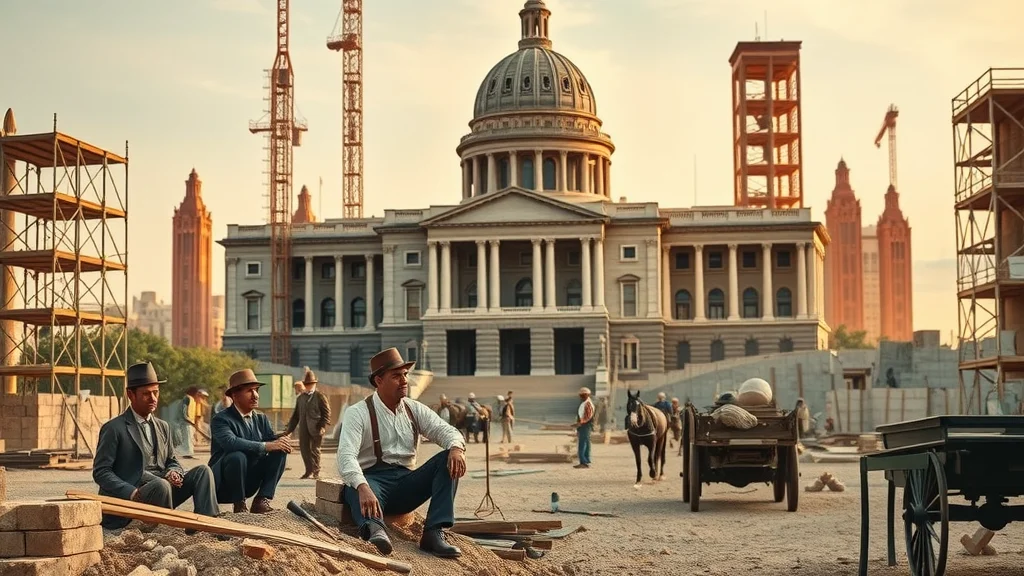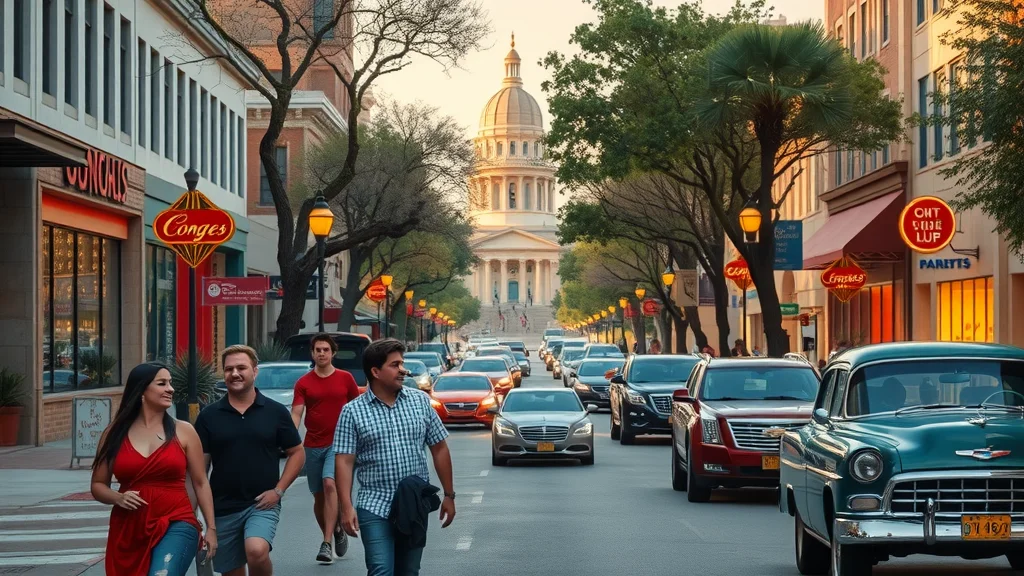Hook: Did you know that Austin, Texas, which today buzzes with music and tech startups, was once a sleepy settlement called Waterloo and nearly lost its right to be the state’s capital? The history of Austin Texas is filled with twists, innovations, and battles for identity that go far beyond its modern reputation.
The History of Austin Texas: An Overview Rooted in Surprising Beginnings
"Did you know the city was originally called Waterloo before becoming Austin—the capital of Texas?"
- The major milestones that shaped Austin’s identity
- Key locations and figures in Austin’s past
- Cultural and historical facts that are not widely known
Austin’s legacy is woven from a tapestry that begins with the Indigenous peoples who first made use of the Colorado River’s resources, through the city’s transformation from Waterloo to the ambitious state capital. By understanding the history of Austin Texas, we step into a world where humble beginnings, grand governmental ambitions, and a relentless drive for cultural change all align. Not only does the city serve as the heart of Travis County, but it quickly established itself as an innovator: constructing the tallest state capitol in the country and laying the academic foundation with the University of Texas at Austin. As you read on, you’ll traverse Congress Avenue, explore the vibrant soul of East Austin, and meet unforgettable characters—from statesmen like Sam Houston to the generations who fought for civil rights and diversity. Whether you’re visiting Austin or calling it home, these stories give every street and landmark a depth beyond the surface.

A Timeline of Austin: Key Dates and Events in the History of Austin Texas
| Year | Event |
|---|---|
| 1839 | Austin chosen as capital along the Colorado River |
| 1883 | University of Texas at Austin founded |
| 1888 | Texas State Capitol building completion |
| 1928 | City Plan influences East Austin developments |
The history of Austin Texas is defined by a series of dramatic chapters. When Austin was chosen as the capital in 1839, its strategic location on the Colorado River made it ideal both as a center for governance and a launchpad for future prosperity. Over the decades, various city-defining moments unfolded: the founding of the University of Texas at Austin in 1883 transformed Austin into a beacon of education and research; the completion of the iconic Texas State Capitol in 1888 cemented the city’s stature. By 1928, city planning driven by new social and economic ideas would shape the neighborhoods—especially the historic East Austin, which became a cultural crucible. Throughout each epoch, Austin balanced progress and preservation, welcoming influences from pioneers, civil rights leaders, and creative communities. This resilience and evolution define why so many find the city’s story so compelling.
Austin’s Early Days Along the Colorado River
Indigenous Peoples and Settlement Before Austin

Long before Waterloo or Austin was founded, Indigenous communities flourished along the Colorado River. Tribes such as the Tonkawa, Comanche, and Lipan Apache built a way of life that revolved around the river’s nourishing waters and abundant wildlife. These early inhabitants ingeniously utilized the lush floodplains for hunting, fishing, and gathering, creating seasonal camps that would form the blueprint for communal living in the area. The riverbank forests teemed with native flora and fauna, providing shelter, food, and spiritual inspiration. Evidence of these societies remains embedded in local artifacts and oral traditions, offering a testament to their enduring relationship with the land. As Spanish and then Anglo-American settlers ventured into what are now the city limits of Austin, this deep-rooted legacy persisted, quietly shaping the evolving culture and respect for the region’s natural beauty. Today, the echoes of these communities can still be felt in historic parks and river trails throughout Travis County.
The Founding of Waterloo and Renaming to Austin
The settlement that became Austin began as Waterloo—a small outpost along the lower Colorado River. Chosen in 1839 as the new capital of the Republic of Texas, Waterloo’s location was selected for its accessibility and scenic vantage. However, the name would soon be replaced to honor Stephen F. Austin, the “Father of Texas,” who played a crucial role in the state’s founding. As the city took shape, its original grid was dictated by the river’s course and frequent floods. Primitive wooden structures, early businesses, and family homes lined muddy paths that would one day become famous avenues. The fledgling capital’s identity quickly wove together frontier ambition with the promise of cultural growth. Despite periods of political uncertainty (where rivals like Houston or San Antonio sought the state capitol honor), Austin persevered—its new name and bolder aspirations a symbol for future generations. This pivotal transition set the tone for the city’s ongoing journey of reinvention.
Austin Becomes the Capital: Texas State Government and State Capitol
The Fight to Keep Austin as the Capital in Texas History
Establishing Austin as the permanent capital of Texas was no small feat. Throughout the 19th century, the city’s status shifted as political storms swept across the Republic of Texas and, later, the state. Sam Houston, first president of the Republic, initially opposed the move from Houston and even tried to relocate the government, citing security and logistical issues. Yet the central location on the Colorado River and the vision of city planners—supported by leaders like Mirabeau B. Lamar—won out. When the Civil War and subsequent Reconstruction left the region in unrest, Austin still remained the seat of government. It was here that political icons from every era, including Lyndon Baines Johnson, would start their journeys. Decades of struggle eventually established Austin as not only the political heart of Texas history but also a center for social and cultural transformation, echoing in every legislative session and statewide movement for change.
Building the Iconic Texas State Capitol on Congress Avenue

Constructed between 1882 and 1888, the Texas State Capitol remains one of the most recognizable structures in the United States. Its spot at the head of Congress Avenue was chosen for commanding both symbolic and literal views—asserting Texas pride in the skyline. Designed by architect Elijah E. Myers, the building featured local “sunset red” granite, limestone, and an elaborate cast-iron dome that, even today, stands taller than the U.S. Capitol in Washington, D.C. As the center of political life in Travis County, the capitol was designed to host not only legislative sessions, but pivotal state events—from Baines Johnson’s speeches to decades of advocacy. The project provided jobs across the region, attracting skilled workers and artisan builders. Today, the Texas State Capitol is a living museum of Texas history, drawing thousands for daily tours, protests, and festivals—all while anchoring the city’s historic and modern identity. Every stone tells a chapter in Austin’s resilient story.
Academic Achievements: The University of Texas at Austin
How the University of Texas at Austin Shaped the City’s Growth

Since its founding in 1883, the University of Texas at Austin has played a transformative role in Austin’s development. This flagship institution quickly grew into a major research and cultural powerhouse, drawing students, scholars, and innovators from across the United States and well beyond. The university launched Austin’s rise as a center for new ideas, progressive movements, and scientific, artistic, and athletic achievement. It serves as a training ground for influential leaders, including Lyndon Baines Johnson and numerous Nobel laureates. The campus, crowned by the UT Tower and home to iconic libraries and museums, fuels diverse opportunities in technology, politics, and the arts. Economic impact is also immense: UT acts as a magnet for major employers and tech startups, helping Austin become what’s often called “Silicon Hills.” Through every era, the University of Texas has inspired a unique blend of cosmopolitan energy and authentic Texan spirit, making it instrumental to the city’s ever-evolving story.
The Rise of East Austin: Cultural and Social Shifts in the History of Austin Texas
Segregation, Civil Rights, and Urban Planning in East Austin
East Austin is central to understanding the true heart of the city’s transformation. Historically, city planning decisions—like the infamous 1928 Austin City Plan—forced many African Americans and Mexican Americans to relocate east of what is now Interstate 35, shaping neighborhood dynamics for generations. Despite segregation, East Austin became a vibrant community with rich musical, culinary, and artistic legacies. The area fostered influential figures in civil rights, politics, and the creative industries, all against the backdrop of systemic inequality. Over the years, activists and residents battled inequities, advocated for better schools and public resources, and shaped a lasting spirit of unity and resilience. Today, when we discuss Texas history and the ongoing identity of Austin, East Austin takes center stage—not only for its role in the past, but for its ongoing contributions to the city’s social fabric and dialogue around equity, representation, and preservation.
East Austin’s Role in Modern Cultural Movements
In recent decades, East Austin has transformed from a site of historical struggle to a hotbed of innovation in culture, art, and activism. Musicians, muralists, chefs, and entrepreneurs have made East Austin a national destination for creativity and inclusion. Iconic venues nurture the music scene, while street art and pop-up events celebrate both local history and contemporary diversity. Gentrification has brought significant change, but community organizations actively work to preserve heritage, provide affordable housing, and celebrate the area’s ancestral voices. East Austin’s story is still unfolding, symbolizing the larger journey of Austin—a place where perseverance, diversity, and reinvention create something wholly unique in Texas history. Each block, mural, and festival reminds visitors and locals alike that Austin is, at its core, a city that learns and changes, never forgetting the roots that made it strong.
Congress Avenue: The Spine of the History of Austin Texas
Landmarks Along Congress Avenue and Their Role in Texas History

As the main axis of power and culture in the history of Austin Texas, Congress Avenue has seen the evolution of nearly every important city event. Designed as the city’s original grand boulevard, its straight path leads directly from the Colorado River north to the doors of the Texas State Capitol. Over the decades, Congress Avenue became lined with some of Austin’s most significant landmarks—historic theaters, banks, hotels, and government offices—creating a vibrant streetscape that fuses old and new. This route played host to Victorian-era parades, civil rights marches, and star-studded festivals. The avenue’s architecture reflects the changing times: from frontier abodes to art deco masterpieces to gleaming modern towers. At night, neon lights and bustling traffic breathe life into the city’s history. Congress Avenue remains the connective tissue for de Austin’s political, social, and spiritual journey—a public square where Austin’s past and future converge, inviting everyone to be part of the next chapter.
Austin’s Reputation: Why Is Austin So Famous?
- Major cultural events (SXSW, ACL)
- Live music capital
- Influences from university and tech sectors
What sets Austin apart from other cities is its magnetic blend of innovation, artistry, and tradition. Known worldwide as the “Live Music Capital of the World,” Austin welcomes millions each year for events like South by Southwest (SXSW) and Austin City Limits (ACL)—holidays unto themselves for music, film, and technology enthusiasts. The city’s creative DNA also comes from the proximity of the University of Texas at Austin, whose research and entrepreneurs fueled Austin’s rise as a high-tech hub (sometimes called “Silicon Hills”). At the very core of its identity, Austin blends food, sports, activism, and an irreverent “Keep Austin Weird” energy. No matter your background or interest, the city’s open-mindedness and drive for innovation have earned it a legendary reputation in Texas, the United States, and beyond. That’s why the history of Austin Texas is truly a story of ongoing fame and fascinating reinvention.
Five Interesting Facts about the History of Austin Texas
- The city’s original grid was enforced by the Colorado River’s floodplain.
- The Texas State Capitol is taller than the US Capitol.
- ‘Keep Austin Weird’ has 1970s roots.
- The Moonlight Towers—unique to Austin—are a link to 19th-century innovation.
- Dirty 6th (Sixth Street) was historically a trade route and is now party central.
Austin is a city defined by its quirks and innovations. When early surveyors brought order to the wilderness, they were forced to respect the Colorado River’s dynamic floodplain, shaping unique neighborhoods that persist to this day. The Texas State Capitol, completed in 1888, is not only a marvel of design but stands as a physical statement of Texas pride—rising higher than its federal counterpart in Washington, D.C. “Keep Austin Weird” may seem like a recent catchphrase, but locals have rallied around eclectic expression for decades, especially since the 1970s. One cannot forget the whimsical Moonlight Towers, relics of 19th-century lighting innovation and urban planning, which remain unique in both United States and European city layouts. And, of course, “Dirty 6th”—once an old trade route—becomes a nightly festival of music, nightlife, and youthful energy, telling the city’s story with every note.
Fascinating Landmarks: From Texas State Capitol to Dirty 6th
- Texas State Capitol
- Congress Avenue
- University of Texas at Austin
- East Austin neighborhoods
- Dirty 6th (Sixth Street)
"Dirty 6th isn’t just a party street—its transformation tells the story of Austin’s evolution."

Every visit to Austin should include a tour of these legendary landmarks. The Texas State Capitol anchors the heart of civic life and opens a window into Texas history. Congress Avenue isn’t just a road; it’s an evolving showcase of cultural, political, and entertainment milestones—from classic theaters to new urban art. At the University of Texas at Austin, you’ll experience the academic pulse that now powers tech, sports, and the arts scene. In East Austin, the neighborhoods tell stories of resilience, creativity, and diversity—where each block offers a surprising blend of tradition and innovation. Lastly, Dirty 6th is not simply a party zone: its lively streets, live music, and historic buildings draw locals and travelers alike, serving as both time capsule and launching pad for new adventures in the city.
People Also Ask:
What is Austin, Texas known for historically?
Austin is historically known for being the capital of Texas, its vibrant musical and cultural scenes, the University of Texas at Austin, and its diverse blend of politics, art, and technology. Its roots as Waterloo, its role along the Colorado River, and its evolution amid changing demographics make it distinctive in Texas history.
What are 5 interesting facts about Austin?
1) Originally called Waterloo.
2) Texas State Capitol is the tallest state capitol.
3) Known for Moonlight Towers.
4) The University of Texas at Austin is a major research hub.
5) 'Keep Austin Weird' is a local rallying cry.
Why is Austin so famous?
Austin is famous for its live music scene, world-renowned landmarks like the Texas State Capitol and University of Texas at Austin, its unique culture symbolized by East Austin and Dirty 6th, and a legacy of innovation and creativity.
What is Dirty 6 in Austin?
Dirty 6th refers to a segment of Sixth Street famous for its nightlife, live music venues, and vibrant energy—a historical corridor that mirrors the city’s changing culture.
Frequently Asked Questions on the History of Austin Texas
- When was Austin founded?
- What major events shaped East Austin?
- How did the Colorado River influence Austin's layout?
- What is the significance of the Texas State Capitol?
Key Takeaways from the History of Austin Texas
- Austin’s roots stretch from early settlements to a modern cultural hub
- The Colorado River, Congress Avenue, and East Austin play pivotal roles
- Institutions like the University of Texas at Austin and Texas State Capitol symbolize growth

Discover More Austin Stories—Explore Local Museums and Archives
Take your knowledge further by visiting local museums and archives throughout Austin. Start at the Bullock Texas State History Museum, the Austin History Center, and community archives in East Austin—where every artifact and exhibit deepens your appreciation for the city’s remarkable journey.
Conclusion: The history of Austin Texas reveals a city of resilience, creativity, and constant transformation. Dive deeper, and you’ll uncover stories that make the city’s spirit truly unique—yesterday, today, and tomorrow.
 Add Element
Add Element  Add Row
Add Row 

Write A Comment